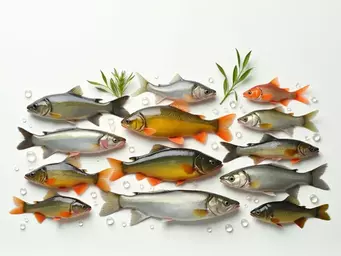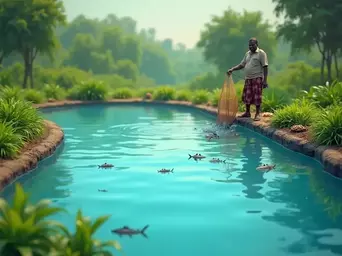Species Impact:
Tilapia
Generally considered sustainable, requiring less feed conversion compared to other species.
Unlock strategic insights and practical guidance for your aquaculture venture. Join our community of thriving fish farmers!
Posted on: 2025-09-03
By: Kwame Adom
As fish farming grows in importance across Africa, understanding market dynamics and sustainable practices is essential for any aspiring aquaculture entrepreneur. The right fish species can significantly influence both profitability and environmental impact. Here’s what you can gain from exploring these insights.
A comparative look at the environmental footprint and sustainability aspects of popular fish species in aquaculture.
Generally considered sustainable, requiring less feed conversion compared to other species.
Highly adaptable, but some varieties may require more resources for optimal growth.
Typically low-impact, as they can thrive in diverse environments and often utilize lower-quality feed.
While economically valuable, their farming can lead to overfishing if not managed correctly.
When diving into the world of aquaculture, one of the most crucial factors to consider is the selection of fish species. Choosing the right species can significantly impact the sustainability and profitability of your fish farming venture. This decision is not merely about what looks good in your pond; it’s about aligning your farm's goals with local market demands and environmental conditions. To learn more about optimizing your farm's output, explore our guide on maximizing aquaculture output.
As I’ve learned through my years in fish farming across various African nations, the right species selection not only influences growth rates but also plays a vital role in maintaining healthy ecosystems. With the rising demand for fish as a protein source, understanding which species to cultivate is more important than ever!
Selecting profitable fish species is a foundation for sustainable farming. It allows farmers to maximize their yield while minimizing environmental impact. Here are some key reasons why this matters:
By focusing on profitable species, we not only secure better financial returns but also support sustainable practices that benefit our communities and environments.
The African aquaculture market is evolving rapidly. We’re seeing significant trends that influence fish species selection, including increased urbanization and changing dietary preferences. Here are a few notable trends:
These trends underscore the importance of selecting the right fish species, as they directly correlate with market success and sustainability in aquaculture.
Understanding consumer preferences is essential for any fish farming business. By aligning fish species with local tastes and demands, farmers can enhance their market reach. Here’s what I’ve found to be important:
By tailoring our fish species selection to these preferences, we not only meet market demands but also elevate the overall quality of our aquaculture practices.
Now that we understand the importance of species selection, let’s delve into how we can identify the most profitable fish for aquaculture. It’s crucial to evaluate several key factors that influence your success.
As you consider the importance of fish species selection, what factors do you find most critical? Is it market demand, sustainability, or perhaps the environmental impact? Share your thoughts below!
As I delve deeper into the world of aquaculture, one thing becomes increasingly clear: environmental sustainability is not just an option; it's a necessity. In a rapidly changing world, the practices we adopt today in fish farming will shape the future of our industry and our planet. With the growing demand for fish, it's vital to ensure that our methods not only meet this need but also protect the environment. For more detailed insights into sustainable practices, read our article on sustainable aquaculture practices.
In my experience with Fish Farming Business, I've seen that addressing sustainability can lead to long-term profitability and resilience in our operations. This section will explore how to balance fish production with ecological health, focusing on species selection and farming practices that minimize environmental impact.
When selecting fish species, it’s crucial to consider their environmental impact. Different species have varying effects on ecosystems, which can influence your farming practices. Here's a quick comparison of some popular species:
By understanding these impacts, we can make informed choices about which species to farm. It’s not just about profits; it’s about protecting our environment for future generations!
To ensure that our fish farming practices are sustainable, consider implementing these strategies:
These strategies are not just good for the environment; they can also lead to better yields and healthier fish! At Fish Farming Business, we believe that fostering sustainability is key to creating a responsible aquaculture industry. For more tips on maintaining a thriving farm, check out our insights on optimizing your fish farm.
Maintaining high water quality is vital for sustainable fish farming. Poor water quality can lead to disease outbreaks and reduced growth rates. Here are some essential practices for effective water quality management:
By focusing on water quality, we not only ensure the health of our fish but also contribute to the overall sustainability of aquaculture. Remember, a well-managed farm is a profitable one!
Choosing the right fish species significantly impacts the profitability and sustainability of a fish farming venture. It influences growth rates, market demand, and the overall health of the ecosystem.
Key factors include market demand, resource efficiency (feed conversion, growth cycles), consumer preferences (taste, health benefits, ethical sourcing), and adaptability to local environmental conditions.
Current trends like rising demand for local fish, preference for sustainable practices, and growth in export markets directly influence which species are most viable and profitable for aquaculture.
Sustainable practices include integrated aquaculture, using eco-friendly feeds, efficient water use (e.g., recirculating systems), and regular monitoring and management of water quality and fish health.
High water quality is essential to prevent disease outbreaks, promote healthy growth rates, and ensure the overall well-being of the fish. Regular testing and filtration are key components.
Here is a quick recap of the important points discussed in the article:



 The future of aquaculture in Africa is brimming with opportunities, driven by innovation and sustain
The future of aquaculture in Africa is brimming with opportunities, driven by innovation and sustain
 The increasing demand for fish protein in Africa is creating a wealth of opportunities for aspiring
The increasing demand for fish protein in Africa is creating a wealth of opportunities for aspiring
 As the demand for fish continues to rise, Ghana's aquaculture sector presents a wealth of opportunit
As the demand for fish continues to rise, Ghana's aquaculture sector presents a wealth of opportunit